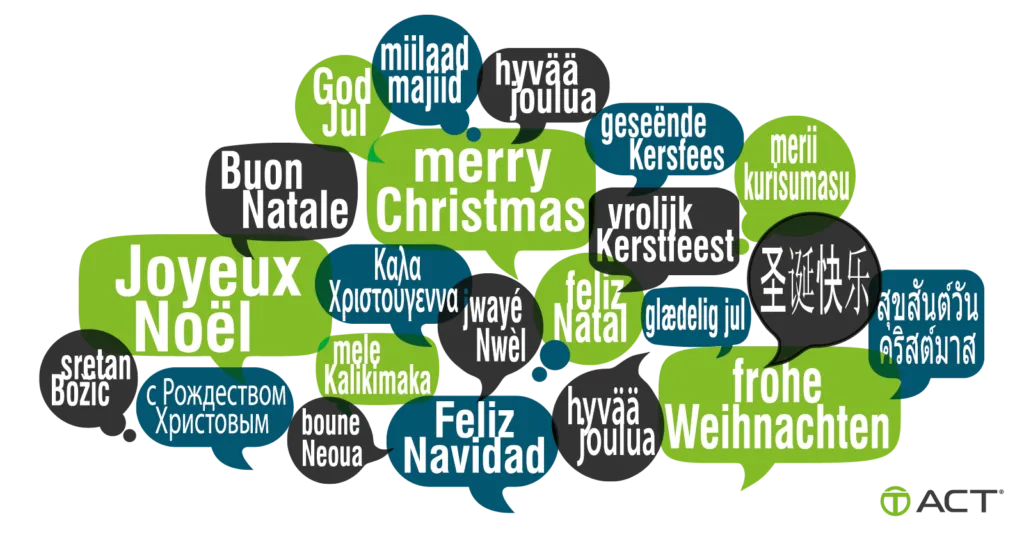Christmas Eve is all about potato salad with sausages, and on Christmas Day itself, it’s goose. The nativity scene has been set up together, and before the presents are handed out, we go for a walk in the woods. We all have our own different Christmas traditions. Many are related to family traditions or regional characteristics. In Sweden, for example, it’s a goat, the “Julbock,” that brings the presents. Maybe you’ve noticed those little straw goats that – starting in the fall – are always on sale at a well-known Swedish furniture store? And according to old tradition, residents of the Scandinavian kingdom put a bowl of porridge on the windowsill as thanks to the elf Tomte for protecting their house and home.
At ACT Translations, we love different languages and cultures. With that in mind, we’d like to invite you on a Christmas journey to discover some other interesting Christmas traditions around the world. Ho ho ho, here are our top six global Christmas traditions:
1. In the UK, they like things to be fun and colorful
While Christmas in Germany is often celebrated in a more contemplative manner, usually with family, things are usually more colorful in Great Britain. There are boisterous company parties in pubs and plenty of brightly colored fairy lights, mistletoe and holly. Many Britons put up their Christmas tree in their living room a couple of weeks before the festive holiday. Added to this, there are many, many Christmas cards that are either placed on the mantelpiece or hung on strings. Sometimes there are a hundred or more Christmas cards – despite the invention of email and Instagram! Children don’t receive their presents until Christmas Day, the smaller ones in a stocking by the fireplace, the larger ones placed under the Christmas tree. The traditional Christmas dinner is turkey with stuffing, as well as plum pudding, mince pies (sweet pastries) and Christmas crackers. These explosive treats traditionally contain a paper coronet for each party guest, a saying or joke, and a small gift. Merry Christmas!
2. In France, you can have a creamy log for dessert
In Germany, the Christkind and the Weihnachtsmann bring the presents, in England, it’s Santa Claus, and in France, the man in red and white is called Père Noël. Christmas gifts are handed out on December 25, because on Christmas Eve – or Réveillon de Noël, as they say in France – the family goes to a festive church service and enjoys a big feast. This usually consists of seven courses and 13 dessert variations. You can tuck into turkey, cheese and the delicious chocolate sponge roll Bûche de Noël: Bon Appétit et Joyeux Noël!
3. In India dad receives a lemon to celebrate the day
The number of Christians in India is just over two percent, which doesn’t sound much when you first read it. But when you consider that there are more than a billion Indians, that adds up to 24 million Christians (more than a quarter of the population of Germany) celebrating Christmas. But because fir trees are not easy to get hold of in India, people there decorate palm trees, banana palms and even mango trees in glittering colors and lights. The churches are filled with bright red poinsettias for the festive period. One custom that probably seems a little unusual for Europeans: the head of the family is presented with a lemon along with many good wishes on Christmas Eve as a sign of love and honor. Shubh naya baras!
4. In Brazil, it snows every year on December 24
While we sing and dream of a white Christmas every year, people in Rio de Janeiro don’t leave it at singing. White and colorful confetti trickles from the windows of the skyscrapers downtown like beautiful flakes, as those Brazilians still working on December 24 (as it’s a normal working day) shed their ties and shred their old papers to ring in the Christmas holidays. By the way, Santa Claus lands in Brazil at the Maracanã stadium. He’s not accompanied by red-nosed Rudolf, however; he is flown in by helicopter. Boas Festas!
5. In the Netherlands, Sinterklaas arrives by ship
The Dutch bearer of gifts is called Sinterklaas. He sets sail by ship from Spain as early as mid-November. This tradition goes back to the days of St. Nicholas of Myra, who died on December 6. According to legend, Sinterklaas, accompanied by his helper Zwarte Piet, rides across the rooftops on a white horse on December 5 and climbs down chimneys to leave gifts in children’s shoes. They thank him by leaving out some water and hay for his horse. There is also the Kerstman, who brings gifts only on Christmas Eve. On this day, many Dutch and also Belgians go to church. Vrolijk Kerstfeest!
6. In Iceland, the Christmas Cat causes all kinds of stress
Santa Claus, Père Noël and Sinterklaas – they’re all good-natured fellows who make children’s eyes light up all over the world. Jólakötturinn is a different story: the Icelandic Christmas cat is the pet of the troll-witch Grýla. During Advent, she spreads fear and terror among children who do not follow the rules of their parents and teachers. The witch’s 13 sons keep the grim pussycat company and wreak havoc on Iceland between December 12 and January 6. Gleðileg jól!

We could give you a whole lot more examples of fun, unusual and beautiful Christmas traditions around the world at this point. Do you know the Norwegian tradition that says that all scrubbing brushes, brooms or mops must be hidden over Christmas to stop them from being stolen by witches? The big clean-up can wait!
Or the Christmas cucumber hidden in American Christmas trees?
In Slovakia, the gentlemen of the house throw a spoonful of the traditional Loksa pudding at the ceiling: the more dessert sticks, the happier the coming year will be.
At this point – and without any pudding – we wish you a happy 2022! No matter how or where you celebrate Christmas this year: the language experts at ACT Translations wish you a Merry Christmas, Buon Natale! (Italian), Kalá khristúyenna! (Greek) and Sretan Božić (Croatian)!
We know the languages and customs that are important to you and your customers – in 2022 and beyond.







